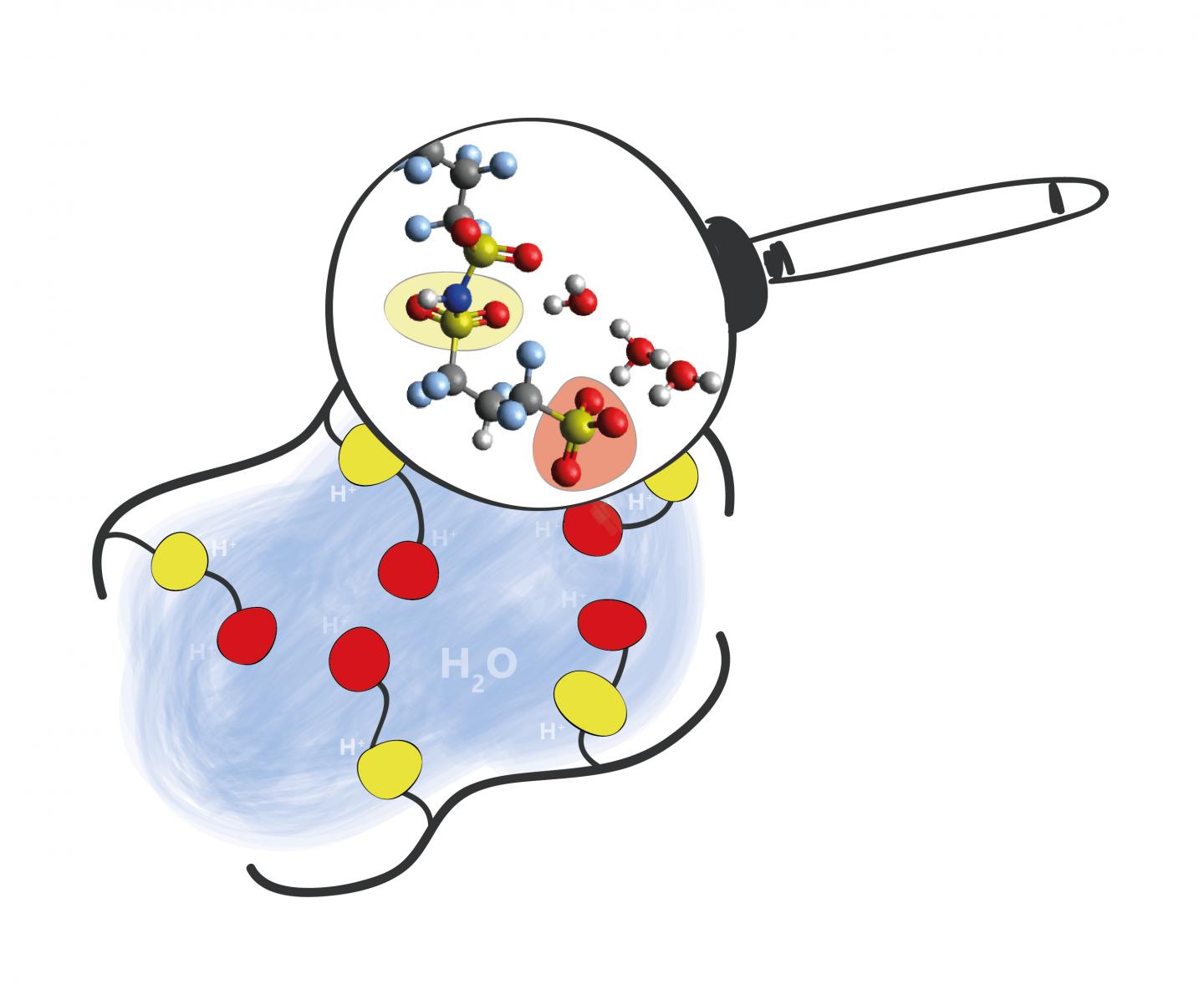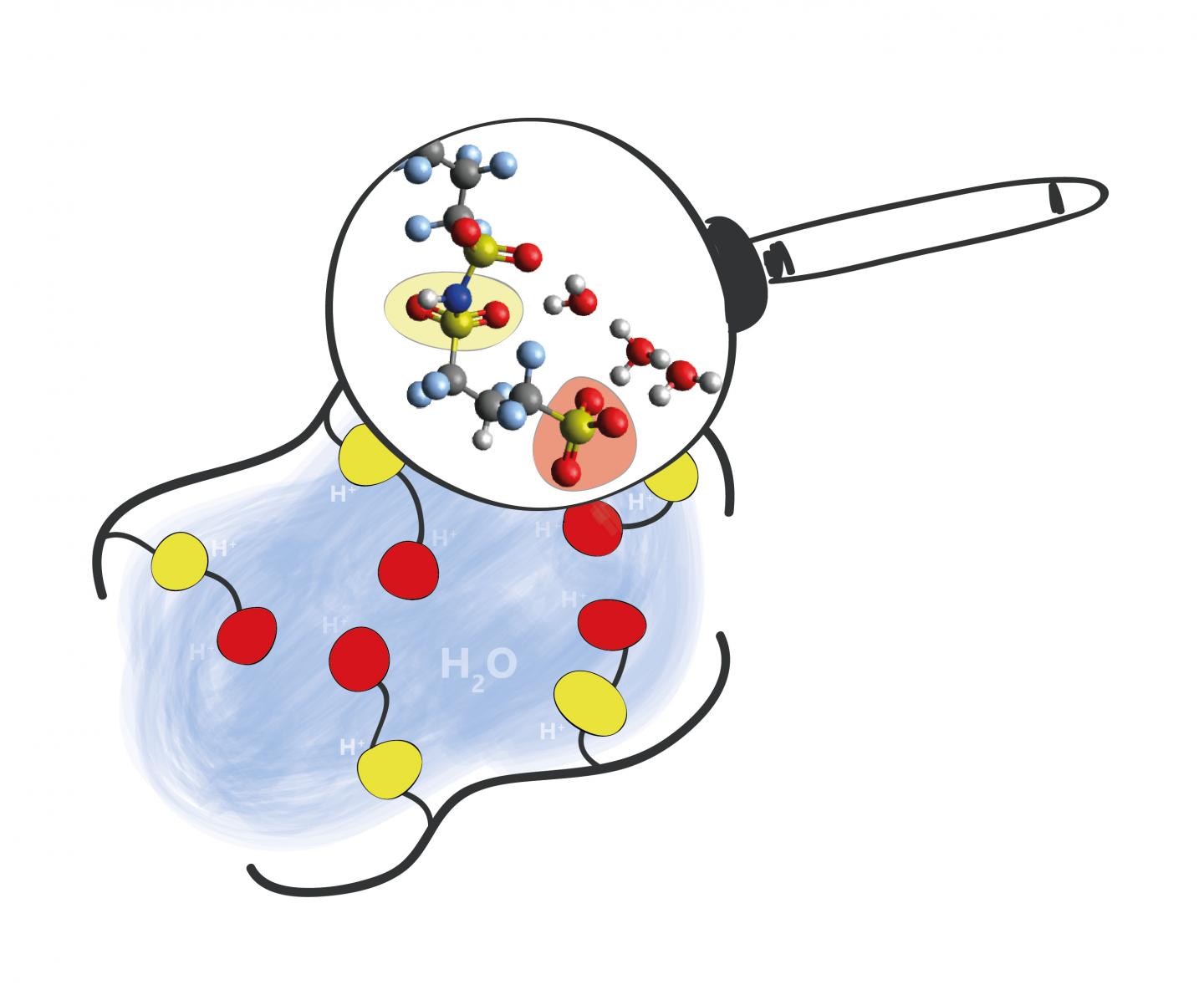
Credit: Heike Cords/HZB
Fuel cells convert chemical energy of fuels such as hydrogen into electricity. The technology is highly efficient and quite clean – with water as its only exhaust. But for wider application either in electric cars or mobile devices, low cost and highly efficient and stable materials are needed. A core component of fuel cells is the proton exchange membrane, which allows protons to selectively diffuse towards the cathode while blocking the oxygen and hydrogen gas. Most commonly used NAFIONTM membrane is only performing well at high humidity conditions and temperatures below 90 °C, thus limiting its efficiency and operational area and increasing the fuel cell cost.
Recently, a different low cost proton exchange membrane material was developed by 3M Company's Fuel Cell Components Group: Perfluoroimide acid or PFIA is already widely applied, but much less understood than NAFIONTM. Whereas PFIA has the same mechanically stable hydrophobic backbone, its hydrophilic side chains contain one more acidic site per each chain than in NAFIONTM. These additional acidic sites on each hydrophilic side chain provide additional protons for the proton transport and allow for the formation of larger water channels. Especially the water management in the PFIA membrane is of interest, since it is crucial for the performance of the fuel cell: in order to function it needs to be humid but never wet.
Now a science team at HZB analyzed PFIA membrane samples, provided by 3M. They combined infrared spectroscopy methods at BESSY II and examined the samples in situ under different temperatures and humidity conditions. By means of statistical analysis and advanced mathematical evaluation of the data, they could deduce the sequence of molecular events connected to the loss of water and reconstruct how water is retained in the PFIA molecules. "We wanted to better understand the behavior of water inside the nano-sized water channels of the proton exchange membranes, particularly during the transition to dryer conditions", Dr. Ljiljana Puskar, first author of the publication, explains.
The experimental data reveal a huge difference in the water management between NAFIONTM and PFIA in low humidity conditions: "We can clearly see that PFIA is better at both water retention and water uptake", Puskar says. They could even deduce how water is retained in the PFIA membrane at dryer conditions: The multiple side chains of PFIA are ideally suited to host water molecules and give rise to the building of a hydrogen bonded network. "These experiments have provided a much better understanding of the water retention capability of PFIA membranes.
This is very helpful for further optimization of such membranes to extend their operational area to higher temperatures and low humidity", Puskar states. She is looking forward to further cooperation projects with 3M. "This is a significant step forward in addressing the water management in an alternative proton exchange membrane type in collaboration with 3M company using the infrared facilities of BESSY II synchrotron. We are further expanding the capability of this excellent facility to allow for operando IR spectroscopy and microscopy and address a wide range of applications related to energy materials in operation, " states Prof. Emad Aziz, who is directing the HZB Institute of Methods for Materials development.
###
Publication: INFRARED DYNAMCIS STUDY OF THERMALLY TREATED PERFLUOROIMIDE ACID PROTON EXCHANGE MEMBRANES; L. Puskar, E. Ritter, U. Schade, M. Yandrasits, S. J. Hamrock, M. Schaberg, and E. F. Aziz. Phys. Chem. Chem. Phys., 2017, DOI: 10.1039/C6CP06627E
Media Contact
Dr. Antonia Roetger
[email protected]
49-806-243-733
@HZBde
http://www.helmholtz-berlin.de
############
Story Source: Materials provided by Scienmag





